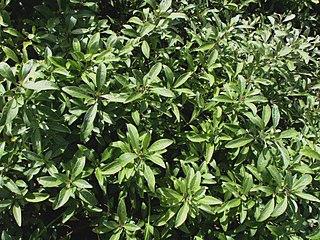
Acmena was formerly the name of a genus of shrubs and trees in the myrtle family Myrtaceae. The genus was first formally described in 1828 by Augustin Pyramus de Candolle in his Prodromus Systematis Naturalis Regni Vegetabilis.

Nototrichium divaricatum, also known as Na Pali rockwort or kuluʻī (Hawaiian), is a rare perennial shrub in the pigweed family, Amaranthaceae, that is endemic to the island of Kauaʻi in Hawaiʻi. It can be found in the northwestern part of the island in dry to moist shrublands, where it grows on north-facing cliffs and ridges.
Viburnum divaricatum is a species of plant in the Adoxaceae family. It is endemic to Ecuador. Its natural habitat is subtropical or tropical moist montane forests. It is threatened by habitat loss.

Galium divaricatum is a species of flowering plant in the coffee family known by the common name Lamarck's bedstraw.
Daddy longlegs or daddy long legs may refer to:

Ribes divaricatum is a species in the genus Ribes found in the forests, woodlands, and coastal scrub of western North America from British Columbia to California. The three accepted varieties have various common names which include the word "gooseberry". Other common names include coast black gooseberry, wild gooseberry, Worcesterberry, or spreading-branched gooseberry.

Oncidium divaricatum is a species of orchid found from southeastern and southern Brazil to northeastern Argentina.

Carpesium is a genus of flowering plants in the aster family, Asteraceae. They are distributed in Europe and Asia; most occur in China and several are endemic to the country.
Gracility is slenderness, the condition of being gracile, which means slender. It derives from the Latin adjective gracilis, or gracile (neuter), which in either form means slender, and when transferred for example to discourse takes the sense of "without ornament", "simple" or various similar connotations.

Stylidium divaricatum, known by the vernacular name daddy-long-legs, is a species in the genus Stylidium that is endemic to Western Australia.

Melampodium leucanthum, the plains blackfoot or blackfoot daisy, is an herbaceous perennial plant in the family Asteraceae found on limestone-containing rocky slopes in the Sonoran Desert. It is an attractive ornamental with showy flowers and long bloom period, from March to November.
Conium divaricatum is a species of flowering plant in the family Apiaceae, native to Greece, including Crete. It was first described in 1856.
Croptilon divaricatum, called the slender scratchdaisy, is a North American species of flowering plants in the tribe Astereae within the family Asteraceae. It is native to the southeastern and south-central United States, in the states of Texas, Oklahoma, Arkansas, Louisiana, Mississippi, Alabama, Florida, Georgia, Virginia, and the Carolinas.
Gold Medallion may refer to:

Leptospermum divaricatum is a species of plant that is endemic to inland New South Wales. It is an erect or weeping shrub with compact fibrous bark, elliptical to egg-shaped leaves, white flowers arranged singly on short axillary side shoots and woody fruit that fall off when mature.

Aichryson divaricatum is a species of succulent plant of the family Crassulaceae endemic to Madeira.

Symphyotrichum divaricatum is an annual and herbaceous plant commonly known as southern annual saltmarsh aster. It is native to the southern United States and some northern states of Mexico.

Lysiloma divaricatum is a flowering tree native to Mexico and Central America. Common names include mauto, quitaz, and tepemesquite in Mexico, quebracho in Honduras, Mexico, and Nicaragua, and quebracho negro, tepemisque, and yaje in El Salvador.
Stenanthemum divaricatum is a species of flowering plant in the family Rhamnaceae and is endemic to the southwest of Western Australia. It is a small, often spiny shrub with sparsely hairy young stems, fan-shaped to narrowly egg-shaped leaves and densely, softly-hairy heads of tube-shaped flowers.












